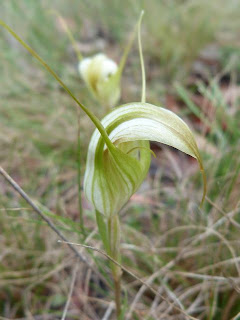The impact of record rainfall: 3 Orchids
This is part 3 of a series about things related to the soggy Summer.
While wandering about photographing the plethora of fungi I suddenly noticed about 20 greenhood flowers waving in the grass.
Here is a close up of the labellum (more or less to prove I don't always trigger them).
As there were no rosettes visible I concluded that this was a Diplodium sp rather than Pterostylis sp. That being the case green labellum suggests D. reflexum. This has since been confirmed by a couple of experts.
Note from the future (2 March): I discovered another of these plants about 300m away, in a very similar habitat.
Even further in the future! On 3 March I found yet another colony on Whiskers Creek Road - about 1km in a straight line form the initial lot. Here are a couple of images.
The initial colony had completely 'gone over' by 7 March.
In case anyone is interested here is a plot of the position of the three colonies (if the single plant at site 2 can be considered a colony) courtesy of Google Earth). It shows colony 3 is 750m due almost east of colony 1.
While I was showing colony 1 to Frances she pointed down, more or less between my feet, and said "What about the Parsons Bands?" What indeed. These were the first Eriochilus cuculatus I have found on the property this year. Of course once found they were everywhere!
I particularly like this shot. It so reminds me of one of the hell-fire and brimstone merchants with his mouth wide open waving his arms around!
We did find a very pink flower but my image washed out rather badly: we think it was still this species however. On 2 March I revisited the site and got a couple of reasonable images of the pink jobbie (technical term usually applied to the Glasgow form E. c. bigyinensis).
On 7 March there were many many more Eriochilus in the area. I took one photograph since it combined the front and rear views.
While wandering about photographing the plethora of fungi I suddenly noticed about 20 greenhood flowers waving in the grass.
Here is a close up of the labellum (more or less to prove I don't always trigger them).
As there were no rosettes visible I concluded that this was a Diplodium sp rather than Pterostylis sp. That being the case green labellum suggests D. reflexum. This has since been confirmed by a couple of experts.
Note from the future (2 March): I discovered another of these plants about 300m away, in a very similar habitat.
Even further in the future! On 3 March I found yet another colony on Whiskers Creek Road - about 1km in a straight line form the initial lot. Here are a couple of images.
The initial colony had completely 'gone over' by 7 March.
In case anyone is interested here is a plot of the position of the three colonies (if the single plant at site 2 can be considered a colony) courtesy of Google Earth). It shows colony 3 is 750m due almost east of colony 1.
While I was showing colony 1 to Frances she pointed down, more or less between my feet, and said "What about the Parsons Bands?" What indeed. These were the first Eriochilus cuculatus I have found on the property this year. Of course once found they were everywhere!
I particularly like this shot. It so reminds me of one of the hell-fire and brimstone merchants with his mouth wide open waving his arms around!
We did find a very pink flower but my image washed out rather badly: we think it was still this species however. On 2 March I revisited the site and got a couple of reasonable images of the pink jobbie (technical term usually applied to the Glasgow form E. c. bigyinensis).
On 7 March there were many many more Eriochilus in the area. I took one photograph since it combined the front and rear views.













Comments
Nice Greenhoods. Very pleasant surprise t have them pop up in the rain.
Did you consider Dipl. revolutum?
http://peonyden.blogspot.com.au/2011/05/yet-another-greenhood-from-bungonia.html
The Dipl reflexum I got at Tallong were more brownish on the hood, and not as pointed as your lovely plants.
The link from that Bungonia page of mine takes you to Colin Rowan's site where he has more images to compare.
Cheers
Denis
D. revolutum hasn't made it into the ACT Orchid book which defined my first set of possibles.
Following your comment I checked David Jones' "Great Big Book for Boys and Girls". This refers to it as a coastal species and mentions sandy soils a fair bit. So I think it would need a fair bit of investigation to claim it for the shaley paddocks of Carwoola.
Martin